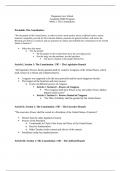Class notes
The Constitution 101
- Course
- ORG24-25 (ORG2425)
- Institution
- Duquesne University
This is all about the constitution of the United States. Understanding how the constitution works, who invented and what it's doing for America and the people in America. The constitution protects us and provides us with our amendments. I also go over the three branches Judicial, Executive, and Leg...
[Show more]



